Archive for June 2013
From fashion statement to social symbol
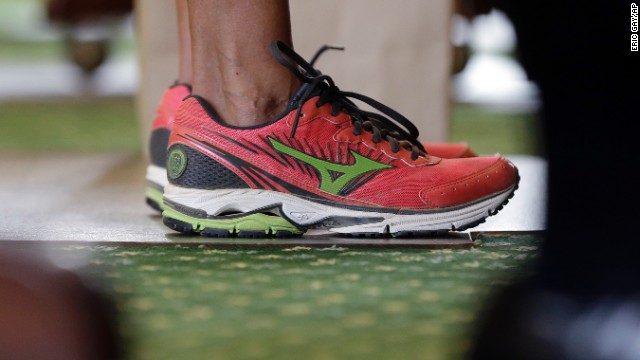 Texas state Sen. Wendy Davis wears running shoes in place of her dress shoes during her one-woman filibuster in an effort to kill an abortion bill on Tuesday, June 25, in Austin, Texas. The shoes became a symbol of the #standwithwendy movement.
Texas state Sen. Wendy Davis wears running shoes in place of her dress shoes during her one-woman filibuster in an effort to kill an abortion bill on Tuesday, June 25, in Austin, Texas. The shoes became a symbol of the #standwithwendy movement. 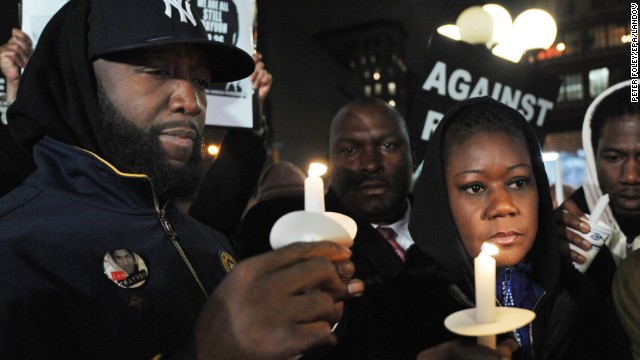 Trayvon Martin's parents, Tracy Martin, left, and Sybrina Fulton, attend a vigil in New York on February 26, 2013, marking the one-year anniversary of their son's death. George Zimmerman is on trial for killing the 17-year-old in Sanford, Florida. Since Trayvon's death, protesters have worn hoodies in solidarity against racial profiling.
Trayvon Martin's parents, Tracy Martin, left, and Sybrina Fulton, attend a vigil in New York on February 26, 2013, marking the one-year anniversary of their son's death. George Zimmerman is on trial for killing the 17-year-old in Sanford, Florida. Since Trayvon's death, protesters have worn hoodies in solidarity against racial profiling.  Turkish riot police spray a woman in Taksim Square with pepper spray on May 28, 2013. The woman in a red dress became an icon of the violent protests in Turkey, making international headlines and spreading across social media.
Turkish riot police spray a woman in Taksim Square with pepper spray on May 28, 2013. The woman in a red dress became an icon of the violent protests in Turkey, making international headlines and spreading across social media.  Men in Bangalore, India, wear skirts on January 12, 2013, during a demonstration against the rape and sexual abuse of women.
Men in Bangalore, India, wear skirts on January 12, 2013, during a demonstration against the rape and sexual abuse of women. 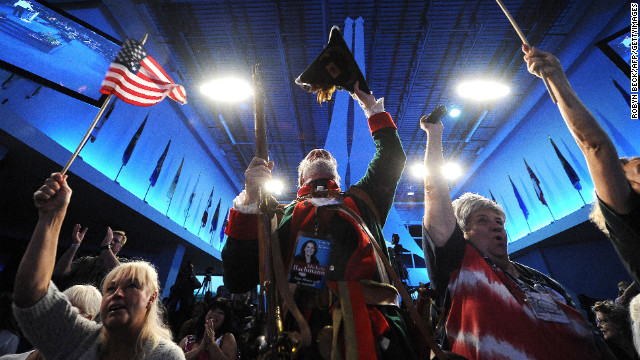 William Temple dresses in colonial attire reminiscent of the 18th-century revolutionary era at the Tea Party Unity Rally ahead of the Republican National Convention in Tampa on August 26, 2012.
William Temple dresses in colonial attire reminiscent of the 18th-century revolutionary era at the Tea Party Unity Rally ahead of the Republican National Convention in Tampa on August 26, 2012. 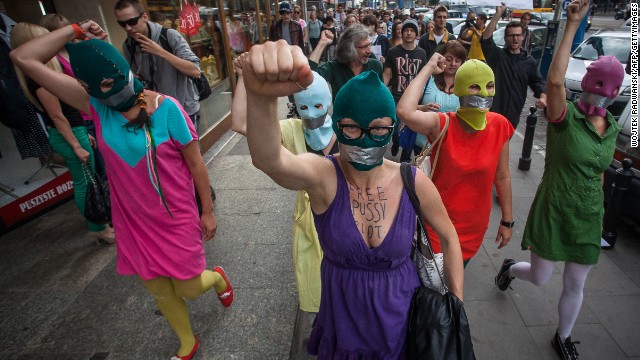 Supporters of the Russian punk band Pussy Riot wear masks and tape their mouths during a protest in front of the Russian embassy in Warsaw on August 17, 2012. The colorful ski masks were popularized by the feminist rockers.
Supporters of the Russian punk band Pussy Riot wear masks and tape their mouths during a protest in front of the Russian embassy in Warsaw on August 17, 2012. The colorful ski masks were popularized by the feminist rockers.  PETA "lettuce ladies" and a "banana boy" prepare to serve vegan hotdogs to passers-by in Washington on July 11, 2012. Not afraid of showing a bit of skin, the animal rights organization is known for using controversial tactics to bring attention to its causes.
PETA "lettuce ladies" and a "banana boy" prepare to serve vegan hotdogs to passers-by in Washington on July 11, 2012. Not afraid of showing a bit of skin, the animal rights organization is known for using controversial tactics to bring attention to its causes.  An Occupy protester wears a Guy Fawkes mask during a May Day demonstration on May 1, 2012, in Oakland, California. The mask has become a symbol of the Occupy movement.
An Occupy protester wears a Guy Fawkes mask during a May Day demonstration on May 1, 2012, in Oakland, California. The mask has become a symbol of the Occupy movement. 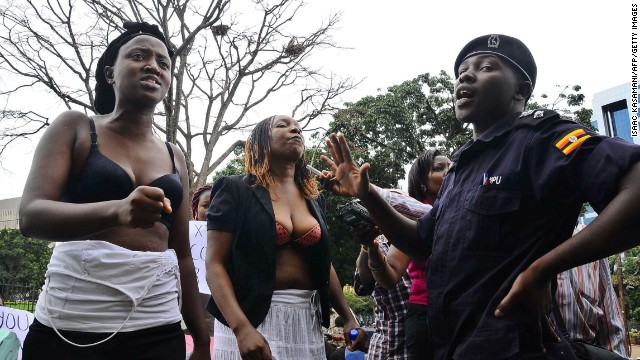 Bra-clad women confront a police officer in Kampala, Uganda, on April 23, 2012. The demonstration was held to protest the alleged sexual assault of a high-profile female opposition politician by a police officer during her arrest. Six women were arrested after they refused to put their shirts on.
Bra-clad women confront a police officer in Kampala, Uganda, on April 23, 2012. The demonstration was held to protest the alleged sexual assault of a high-profile female opposition politician by a police officer during her arrest. Six women were arrested after they refused to put their shirts on.  Egyptian army soldiers beat a young woman during a protest at Tahrir Square in Cairo on December 17, 2011. The shocking image of the "blue bra girl" became a symbol of the oppression and a rallying cry for several thousand Egyptian women.
Egyptian army soldiers beat a young woman during a protest at Tahrir Square in Cairo on December 17, 2011. The shocking image of the "blue bra girl" became a symbol of the oppression and a rallying cry for several thousand Egyptian women.  Yemeni women defiantly burn their traditional veils in Sanaa on October 26, 2011, in protest of President Ali Abdullah Saleh's crackdown on anti-government protesters.
Yemeni women defiantly burn their traditional veils in Sanaa on October 26, 2011, in protest of President Ali Abdullah Saleh's crackdown on anti-government protesters. 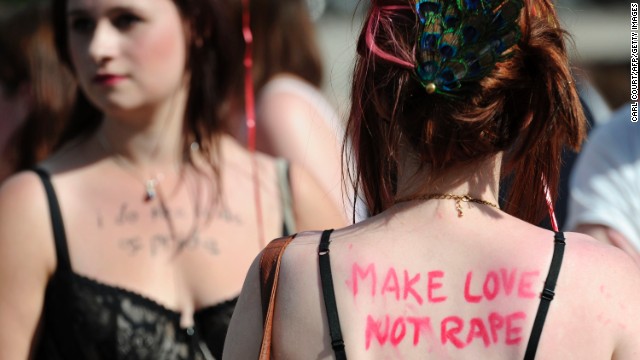 Women take part in a "SlutWalk" protest in central London on June 11, 2011. The global phenomenon was sparked by comments from a Canadian police official who said "women should avoid dressing like sluts in order not to be victimized."
Women take part in a "SlutWalk" protest in central London on June 11, 2011. The global phenomenon was sparked by comments from a Canadian police official who said "women should avoid dressing like sluts in order not to be victimized." 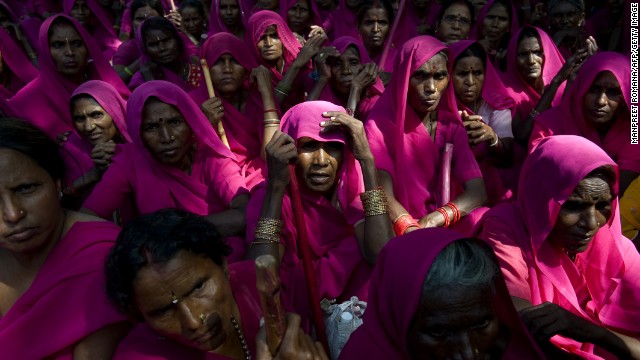 Members of the Gulabi Gang participate in a protest in New Delhi on September 17, 2009. The social justice and women's rights group is known for donning pink saris.
Members of the Gulabi Gang participate in a protest in New Delhi on September 17, 2009. The social justice and women's rights group is known for donning pink saris. 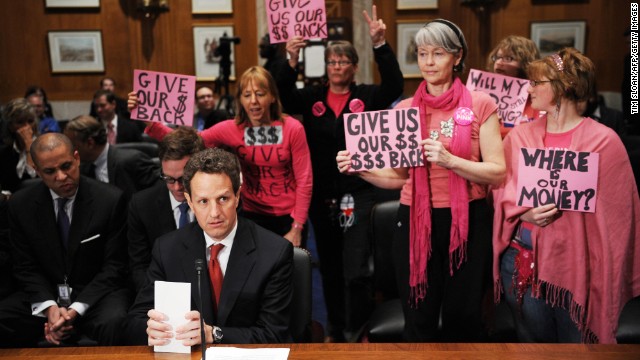 Also claiming the color pink, members of Code Pink often stand out in Washington. The group, a women-initiated peace activism organization, is seen here as Treasury Secretary Timothy Geithner prepares to testify at a congressional hearing on April 21, 2009.
Also claiming the color pink, members of Code Pink often stand out in Washington. The group, a women-initiated peace activism organization, is seen here as Treasury Secretary Timothy Geithner prepares to testify at a congressional hearing on April 21, 2009.  Supporters of Iranian presidential candidate Mir Hossein Mousavi shout slogans during a street campaign rally at Azadi Square in Tehran on June 10, 2009. The color green became a symbol of solidarity in the protests that followed the country's 2009 elections.
Supporters of Iranian presidential candidate Mir Hossein Mousavi shout slogans during a street campaign rally at Azadi Square in Tehran on June 10, 2009. The color green became a symbol of solidarity in the protests that followed the country's 2009 elections.  Girls attend a gay pride celebration in San Francisco on June 29, 2008. The colors of the rainbow flag are often used to represent LGBT identity and solidarity.
Girls attend a gay pride celebration in San Francisco on June 29, 2008. The colors of the rainbow flag are often used to represent LGBT identity and solidarity. 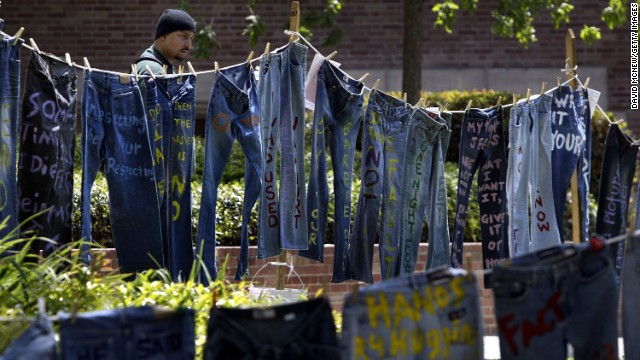 A man looks at blue jeans with messages challenging misconceptions about sexual violence at the University of California Los Angeles on April 21, 2004. Since 1999, wearing jeans on Denim Day became a symbol of protest in response to an Italian Supreme Court decision that overturned a rape conviction because, the justices reasoned, the victim wore tight jeans and must have helped her attacker remove her pants.
A man looks at blue jeans with messages challenging misconceptions about sexual violence at the University of California Los Angeles on April 21, 2004. Since 1999, wearing jeans on Denim Day became a symbol of protest in response to an Italian Supreme Court decision that overturned a rape conviction because, the justices reasoned, the victim wore tight jeans and must have helped her attacker remove her pants.  A young woman attends the Woodstock music festival in New York in August 1969. Headbands became a symbol of the hippie movement, known for its anti-establishment ideals and peaceful protests. Some of their fashion statements were adopted from Native Americans.
A young woman attends the Woodstock music festival in New York in August 1969. Headbands became a symbol of the hippie movement, known for its anti-establishment ideals and peaceful protests. Some of their fashion statements were adopted from Native Americans. 
1

2

3

4

5

6

7

8

9

10

11

12

13

14

15

16

17

18
- Texas state Sen. Wendy Davis caught national attention for a filibuster to stop an abortion bill
- The pink sneakers Davis wore for comfort also made headlines
- Davis' sneakers join a line of fashion symbols in social revolutions
(CNN) -- When Texas state Sen. Wendy Davis made headlines for a filibuster opposing an abortion bill, it was more than her speech that generated buzz. Davis donned hot pink running shoes as she attempted a 13-hour stand against a Texas bill that includes a provision to ban abortions after the 20th week of pregnancy.
As Davis went on, her filibuster became a trending topic on Twitter and the shoe an iconic visual behind the hashtag #standwithwendy.
Davis' footwear joins a long line of apparel that has become symbolic of resistance, from the Trayvon Martin hoodie to Pussy Riot's balaclava face masks.
The shoes were designed for comfort, but Davis told CNN's AC360, "I underestimated how difficult it would be both physically and mentally. About two hours in, I realized I was in for a long day."
Davis also said she didn't expect her shoes to catch national attention. Mizuno, the makers of the now-famous sneakers, told CNN they were surprised at the sudden hype surrounding the shoe, called the Wave Rider.
"The Wave Rider is designed to give the comfort and cushioning needed whether it's a 5K, a marathon or 10+ hour filibuster," Mizuno spokeswoman Harper Cornell said in a statement.
Cornell wouldn't share sales data for the $115 shoe, but the resulting attention has increased traffic to MizunoRunning.com and the Wave Rider 16 product page, she said. Daily website traffic totals nearly doubled compared to the same day last week. The shoes have garnered rave reviews on online retailer Amazon.com, too.
"We do appreciate Ms. Davis' choice in athletic footwear," the company's statement said. "However, we do not maintain a corporate position related to the topic in discussion."
See also: Hoodie's evolution from fashion mainstay to symbol of injustice
Greene: Living like a sultan at sea

- Bob Greene: On a cruise, if a guest cabin goes unoccupied, that's money that's lost
- Greene met a man who was living virtually full-time on cruise ships at rock bottom rates
- He was living the ultimate beach-bum fantasy, 21st-century style, Greene says
- Greene: The downside is that you are cast adrift in many ways
Editor's note: CNN Contributor Bob Greene is a bestselling author whose 25 books include "Late Edition: A Love Story"; "Once Upon a Town: The Miracle of the North Platte Canteen"; and "When We Get to Surf City: A Journey Through America in Pursuit of Rock and Roll, Friendship, and Dreams."
(CNN) -- The cruise-line industry is a rough business.
Every time a passenger ship leaves port with a guest cabin unoccupied, that's money the cruise operators are never going to see.
Last week Micky Arison, the longtime chief executive of Carnival Corp., announced that he will be stepping down; revenues at the world's largest cruise-ship line have been falling. Arison will remain as chairman of the firm, but a new CEO will step in.

Cruise companies have always had to contend with uncertainties in the economy, which sometimes make travelers cautious about planning leisure trips, and Carnival has faced widespread unpleasant publicity in recent years. The Costa Concordia, owned by a subsidiary of the corporation, ran aground and partially sank off the coast of Italy in 2012, killing 32 people. This year the Carnival Triumph lost power in the Gulf of Mexico after a fire in the engine room, creating distressing conditions onboard for its more than 3,000 passengers.
The very nature of the cruise business -- the relentless competition between various lines, the need to fill those staterooms, a fickle public with a multiplicity of options for how and where to vacation -- might cause sleepless nights for executives, but for certain people, it provides a dream scenario:
A seldom-considered way to live the ultimate beach-bum fantasy, 21st-century style.
It's not for everyone. You need to, at least temporarily, have unlimited time on your hands, and you need to have saved, or come upon, some money that you won't one day regret using up this way.
Bob Greene
And a desire, at least once during your time on Earth, to live your life as if it's a Jimmy Buffett song.
A few years back, I was on a cruise ship after a week at sea with the Surf City Allstars, the band with whom I occasionally travel and sing. Most of the passengers, on that final morning, were harried and tense about gathering up all their baggage and making the jarring reentry to the mundane real world. The fun was over.
But in a lounge area of the ship, one man sat near us as he waited for his debarkation group to be called. He seemed as serene and calmly blissful as if he was just getting ready to start a cruise, not end one.
That's because he was.
The way he explained it to us, he had parted company with the corporation that employed him; we got the impression that this was not voluntary on his part. He had been given some severance.
So, he told us, he had figured out a way, for a relatively small amount of money, to live, for a while, like a king. Like a sultan at sea.
He was now, he said, residing virtually full-time on cruise ships -- eating gourmet meals, lounging in the sun, listening to music and going to stage shows at night, sleeping in freshly made-up beds with the oceans of the world lulling him to sleep.
How could he do this?
Each week, he explained, he'd get on his computer and do searches for cheap, last-minute cruise deals. There are websites that specialize in exactly that.
He was counting on the need of all those cruise lines to fill every cabin -- he was counting on their willingness to do just about anything to get rid of their inventory (the unoccupied rooms) as their ships were about to sail.
He said that, by waiting until the last minute, and by not particularly caring where the ship with the best bargain was heading, he was able to find astonishing rates. The ship upon which we were talking had been sailing the Caribbean for a week. I believe he told us that the seven-day cruise, with all meals included, had cost him, as the clock ticked down and the rock-bottom price popped up, a little more than $300.
There is no way, on dry land, that you can eat a week of extravagant multi-course dinners in fine restaurants for $300 -- much less get living quarters, entertainment, recreation and all your other meals, too.
That winter, he said, he'd made the decision to base himself in the Fort Lauderdale, Florida, area, near the massive Port Everglades seaport. Occasionally he would have to pay for a night or two in a budget hotel before the next ship left, but his goal was to get off one ship, wait a few hours, and get right back on another.
And, while at sea, get on the internet and search for the next bargain.
For many people, a cruise is a once-in-a-lifetime treat. He had figured out how to make it his everyday world.
Now. . .there are tradeoffs. You don't get to plan in advance and choose exactly where you want to go. But if you do it every week, do you really care if, on a particular week, one of the ports of call is St. Lucia instead of St. Thomas? The Dominican Republic instead of Costa Rica? It doesn't matter -- for you, it's all travel roulette.
The downside -- and it's a huge one -- is that you are cast adrift in many ways.
Eventually, when your money runs out, you are going to have to think about rejoining the world of ambition and ladder-climbing, and trying to make up for lost time. You have to be the kind of person who can be content with the thought that you are accomplishing and accruing absolutely nothing while other people, back on land, are applying for jobs and working for promotions that will bring them financial security.
You have to be comfortable in the company of complete strangers, who materialize and then disappear week-by-week. You can't be a person with a family who is expecting you at the dinner table back home. And, although you don't have to be trust-fund wealthy, you have to somehow have $400 or $500 a week on hand, for weeks on end.
But the opportunity, for a particular kind of person, is there. The modern-day combination of a vast cruise industry, and an internet that makes finding 11th-hour bargains effortless, means that you can, for as long as you are able to get away with it, indulge yourself in an endless summer, letting rootlessness be a virtue.
Probably very few people reading these words will find themselves in a position, or a frame of mind, to do it, but maybe, the next time the cubicle culture begins to feel too confining, just the thought of it will bring a smile.
On gray days, it has for me. I've thought, from time to time, of that guy on the ship, and wondered how long he was able to make it last. Or whether it became a case of too much ice cream -- if he ended up deciding that the long meal of life was not meant to be an infinite succession of desserts.
And whether a fellow like Micky Arison, the head of Carnival, with all of the job's challenges and headaches, ever daydreams of being that guy instead.
Follow @CNNOpinion on Twitter .
Join us at Facebook/CNNOpinion .
The opinions in this commentary are solely those of Bob Greene.
Time for a civic rite of passage

- Michael Brown, Andrew Hauptman: We need a civic rite of passage for young Americans
- Brown, Hauptman: The Franklin Project released a plan for voluntary national service
- They say the plan calls for setting up 1 million full-time service opportunities every year
- Brown, Hauptman: Young people can help fight problems such as dropout crisis, hunger
Editor's note: Michael Brown is CEO and co-founder of City Year, a national service organization. Andrew Hauptman is chairman of Andell Inc., a private investment firm, and chairman and co-founder of City Year Los Angeles. Both are members of The Franklin Project's Leadership Council.
(CNN) -- What if the same number of young people who serve in our armed forces, defending the country, were enlisted to go on offense here at home, fighting persistent but solvable national problems -- the dropout crisis, national parks in need of restoration, and childhood hunger?
It's a big idea, one that could make a period of service -- either military or civilian -- a civic rite of passage for America's young people.
This week, the Franklin Project, an initiative of the Aspen Institute, released a "Plan of Action" to establish a large-scale 21st century system for voluntary national service.


Sparked by a stirring speech by Gen. Stanley McChrystal at the Aspen Ideas Festival last year, the plan calls for establishing 1 million full-time service opportunities every year for young adults, ages 18 to 28, putting domestic national service on par with the more than 1 million Americans on active duty in our armed forces.
It's a plan that is strongly endorsed not only by nonprofit, philanthropic and private sector leaders, but also people who have dedicated their lives to our national security, including former Secretaries of State Madeleine Albright and Condoleezza Rice, former Secretary of Defense Robert Gates, former National Security Advisor Gen. Jim Jones, and McChrystal, who is chairman of the initiative's leadership council.
Linking military and civilian service as "two sides of the same coin" is perhaps the Franklin Project's most resonant chord. A vibrant nation requires a shared sense of commitment and shared experience of service and sacrifice. But as McCrystal observes, "Less than 1% of Americans serve in the military—a historic low during wartime—leading to a broad, complacent assumption that serving the nation is someone else's job."
The plan calls for expanding federal programs that are already working, including AmeriCorps, and generating energy behind new ideas. For example, the plan proposes that President Obama ask all federal agencies to examine how they might tap citizens in service to meet their missions.
FEMA is already saving $60 million by utilizing national service participants to respond to disasters. We can also expand the opportunities provided by the GI Bill to encourage veterans to continue their service at home -- in schools and community centers -- so the nation can continue to benefit from their dedication to a greater cause.
The demand for opportunities to serve has been growing dramatically. In 2011, AmeriCorps received 582,000 applications for only 80,000 positions, and the Peace Corps received 150,000 applications for 4,000 full-time placements. There is an overwhelming desire among the rising millennial generation to give back. Missing are clear pathways and opportunities to serve. As recent polling demonstrates, four in five voters support voluntary national service.
The "Plan of Action" calls for tapping this wellspring of American idealism to meet pressing national challenges. High on the list is the nation's dropout crisis. Each year, more than a million students fail to graduate with their senior class. Dropouts are eight times more likely to be incarcerated, and three times more likely to be unhealthy or unemployed. Absent effective intervention, the 10 million students who are projected to drop out in the next decade will cost the nation $3 trillion in lost wages, health care expenses, welfare benefits and incarceration costs.
The good news is that research has shown that future dropouts can be identified, as early as the sixth grade, by early warning signs such as high absence rate, poor behaviors and getting an "F" in math or English. What's needed to close the gap? More people power.
"We've seen the power of having young adults serve in our school through AmeriCorps," said Los Angeles Superintendent of Schools John Deasy. "When a student doesn't show up to school, they get them back in. When they're behind academically, they help catch them up. These young people bring an infectious energy and idealism that makes a huge difference. The only problem is that we don't have enough of them -- we need to scale up national service and tap more young people to give a year of service. It's a resource you can't put a price tag on."
The Franklin Project's "Plan of Action" has a powerful response: Calling for 120,000 young people to serve as full-time tutors and mentors in the nation's "dropout factories:" the lowest-performing high schools and the elementary and middle schools. It is just one example of how young people, perhaps the nation's greatest untapped resource, can help America succeed.
One day, the most commonly asked question of a young adult can and should be, "Where will you give your year of service?"
The answer to that question is the key to our nation's future success.
Follow us on Twitter @CNNOpinion.
Join us on Facebook/CNNOpinion.
The opinions expressed in this commentary are solely those of Michael Brown and Andrew Hauptman.
Gridlock at the Supreme Court

- Marshall Sonenshine: Equality won for same-sex marriage, but it was far from a slam dunk
- In 1967, court ruled 9-0 in Loving that interracial marriage ban was unconstitutional
- He says Loving had legal and moral clarity; Windsor case at 5-4 vote was politically charged
Editor's note: Marshall Sonenshine was executive producer of the award-winning HBO film "The Loving Story" about the 1967 interracial marriage Supreme Court case of Loving v Virginia, a key precedent on which Windsor relies. He is a lawyer turned investment banker.
(CNN) -- Champions of equal protection had their day in court -- but it was a highly politicized day in the Supreme Court. Unlike the 1967 interracial marriage case of Loving v. Virginia, the gay rights decision in United States v. Windsor, while also a victory for civil rights, is not a moment of legal clarity or coherence. In court politicization, Windsor is closer to Bush v. Gore.
How cases end matters. The Loving case, at 9-0, was a victory for civil rights wrapped in a moment of Supreme clarity; 5-4 Windsor is a victory wrapped in a Supreme food fight.
Almost a half-century ago, Chief Justice Warren delivered a unanimous decision of the United States Supreme Court, invalidating state laws prohibiting interracial marriage. Sixteen states maintained such laws, including Virginia.

Loving invalidated laws banning interracial marriage. Windsor invalidated federal law denying benefits to homosexual couples married in states permitting same-sex marriage. A comparison of the two cases reveals how divided and divisive our court is today.
Richard and Mildred Loving were a mixed-race couple validly married in the District of Columbia, who upon returning home to Virginia faced continuing arrest and harassment by local police for violating Virginia's miscegenation laws.
After a decade-long cat-and-mouse game with the local authorities and a parallel odyssey through Virginia courts, the Lovings were vindicated when a unanimous Supreme Court held that state miscegenation laws were unconstitutional since they "rest solely on distinctions drawn according to race" and have "no legitimate overriding purposes independent of invidious racial discrimination which justifies this classification." The court held marriage to be among the "basic civil rights" that no state can infringe. Doctrine was born.
 Sullivan: Incredibly long struggle
Sullivan: Incredibly long struggle  1 In 10 couples interracial
1 In 10 couples interracial Several years ago, the documentarian Nancy Buirski asked me to executive produce "The Loving Story," a documentary film chronicling a civil rights story and a love story. HBO co-produced the film. America loved Loving, with its legal and moral clarity. The film was a top performer at the 2011 New York Tribeca Film Festival. HBO began airing it on television on Valentine's Day 2012. This year the film won a Peabody.
Loving v. Virginia was notable for its coherence as the court's resolution of a legal odyssey. Today's legal culture includes conservative judges accusing jurists of partisanship at every turn, even the hardest cases. Call it Supreme Gridlock.
The dissent in Windsor excoriates the majority as "hungry" to grandstand in a case it claims was never properly before the court -- ignoring that Edith Windsor had won a judgment for an estate-tax refund that the U.S. government refused to honor unless the Supreme Court would invalidate the Defense of Marriage Act. Justice Antonin Scalia was wedded to his technicalities and indifferent to Ms. Windsor's equities.
The dissent slams the majority for "rootless and shifting" reasoning and claims the majority views DOMA's supporters as having "hateful hearts," a politicized barb at odds with the muted language with which the majority duly inspected the legislative purpose of DOMA.
Scalia is erudite but dead wrong in claiming, "In the majority's telling, this story is black and white. Hate your neighbors or come along with us." Come again? DOMA said the federal government could declare the validly married same-sex couple next door unqualified for any federal benefits extended to married heterosexual couples. And the court's majority is mongering hate?
Joining the politicized dissent is Justice Samuel Alito: "The family is an ancient and universal human institution" and "changes in family structure and in the popular understanding of marriage and the family can have profound effects." One struggles to rest much on these generalities. Similarly one would struggle to rely much on the broad intonations of the overruled state court judge in Loving:
"Almighty God created the races white, black, yellow, malay and red, and he placed them on separate continents. And, but for the interference with his arrangement, there would be no cause for such marriage. The fact that he separated the races shows that he did not intend for the races to mix."
The entire 1967 court could spot poppycock when it saw it. Chief Justice Earl Warren, concerned with precedent more than politics, probably nonetheless had to do some arm twisting to get unanimity, but he got it. In 2013, by contrast, a virulent dissent offers new polemics -- and then accuses the majority of being politicized.
Loving ended with legal and moral clarity. The New York Times headline read, "Justices Upset All Bans on Interracial Marriage, 9-0 Decision Rules." Windsor ended with, well, democracy still working its virulent ways, including at the court, whose members of its right flank were knitting angrily in their chambers. The dissent reaches for judicial temperament but unleashes judicial temper.
Perhaps it is time for a new documentary, "The Windsor Story." This one too will have a happy ending for the original petitioners, but this time told through the lens of Supreme Gridlock.
Follow us on Twitter @CNNOpinion.
Join us on Facebook/CNNOpinion.
The opinions expressed in this commentary are solely those of Marshall Sonenshine.
My late wife is thanking you, too
 Edith (Edie) Windsor, on the right, holds hands with Thea Clara Spyer the day of their wedding, after 40 years together, on May 22, 2007. By then, Spyer was suffering from multiple sclerosis and could move only one finger.
Edith (Edie) Windsor, on the right, holds hands with Thea Clara Spyer the day of their wedding, after 40 years together, on May 22, 2007. By then, Spyer was suffering from multiple sclerosis and could move only one finger.  In this photo taken in the 1960s, Thea Spyer, left, poses with Edith Windsor at The Cloisters, in Washington Heights, New York City.
In this photo taken in the 1960s, Thea Spyer, left, poses with Edith Windsor at The Cloisters, in Washington Heights, New York City. 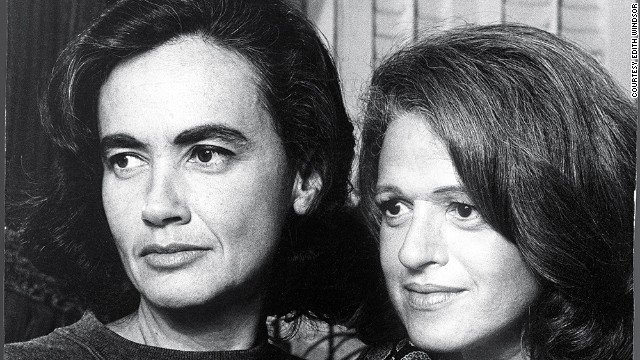 Thea Spyer, left, and Edie Windsor were together for 42 years until Thea's death in 2009.
Thea Spyer, left, and Edie Windsor were together for 42 years until Thea's death in 2009. 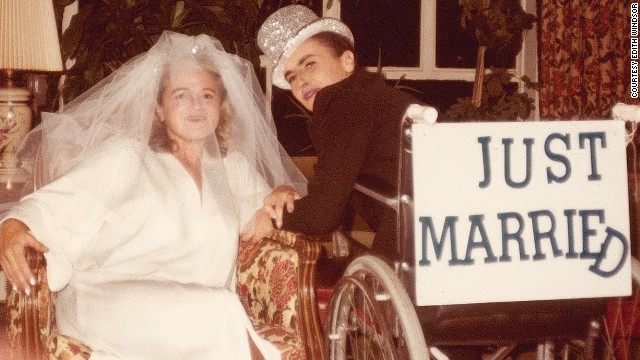 Edie and Thea dress for Halloween sometime in the 1980s, years before they really got married in Toronto, Canada, in 2007. Thea was in a wheelchair because of her MS.
Edie and Thea dress for Halloween sometime in the 1980s, years before they really got married in Toronto, Canada, in 2007. Thea was in a wheelchair because of her MS.  Thea and Edie age gracefully together.
Thea and Edie age gracefully together. 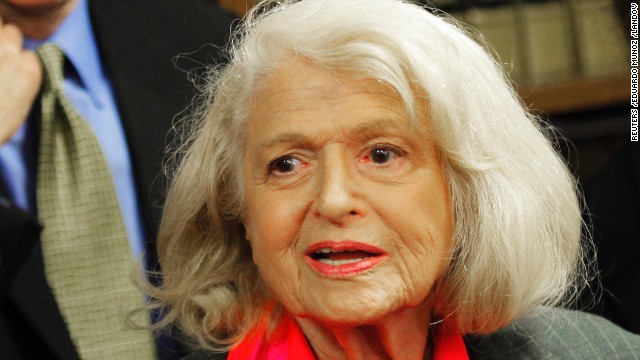 Edie, seen outside the Supreme Court building, was required to pay $363,000 more in estate taxes than she would have had to pay if the federal government recognized her 2007 marriage to Thea.
Edie, seen outside the Supreme Court building, was required to pay $363,000 more in estate taxes than she would have had to pay if the federal government recognized her 2007 marriage to Thea. 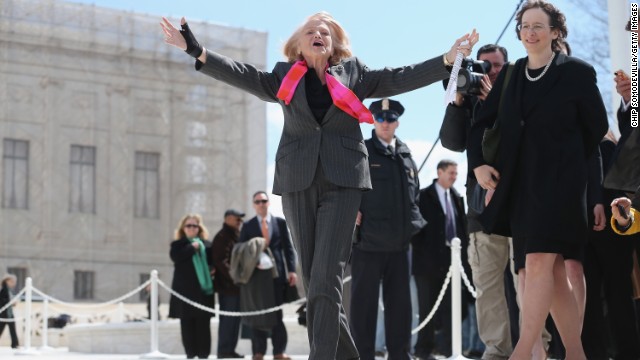 Edie acknowledges her supporters as she leaves the Supreme Court on March 27 after arguments in her case challenging the constitutionality of the Defense of Marriage Act.
Edie acknowledges her supporters as she leaves the Supreme Court on March 27 after arguments in her case challenging the constitutionality of the Defense of Marriage Act. - Edith Windsor won the Supreme Court case that overturned DOMA
- Windsor never thought she would be grand marshal of Pride Parade at 84
- She sued over a tax bill and it led to equality for same-sex married couples
- She was anguished that her government considered her marriage illegitimate
Editor's note: Edith Windsor was the plaintiff in the Supreme Court case challenging the Defense of Marriage Act.
(CNN) -- On Sunday, I will have the honor of serving as grand marshal in the New York City Pride Parade. I have marched in the parade for the last several years carrying a huge rainbow flag. Last year, I was so elated that I danced my way down the street for the entire route.
Before that, my late wife Thea and I, she in her wheelchair, would watch the parade together every year. If someone had told me 50 years ago that I would be the marshal of the New York City Gay Pride Parade in 2013 at the age of 84, I never would have believed it.
Over the past couple of years, many people have asked me, "Why did you decide to sue the United States over a tax bill?" Because the answer is complex, let me give you some of the background.

I lived with and loved my late spouse, Thea Spyer, for more than four decades in love and joy, and in sickness and health, until death did us part. When Thea died in 2009 from a heart condition two years after we were finally married, I was heartbroken.
On a deeply personal level, I felt distressed and anguished that in the eyes of my own government, the woman I had loved and cared for and shared my life with was not my legal spouse, but was considered to be a stranger with no relationship to me.
On a practical level, because of the so-called Defense of Marriage Act, or DOMA, I was taxed $363,000 in federal estate tax that I would not have had to pay if I had been married to a man named Theo instead of a woman named Thea. Even if I had just met Theo, married him and never even lived with him before he died, the tax would have been zero. So, overwhelmed with a sense of injustice and unfairness, I decided to file a lawsuit to get my money back.
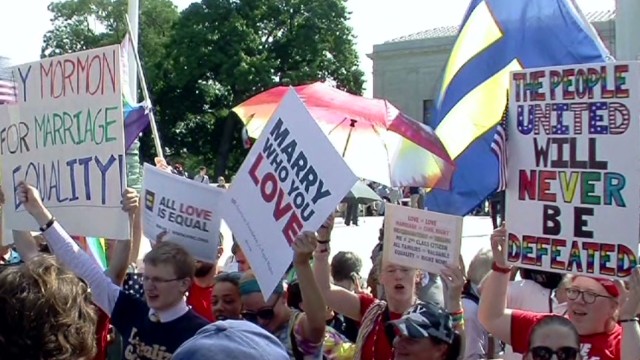 Did Supreme Court make history or not?
Did Supreme Court make history or not?  Watch the best moments from gay day
Watch the best moments from gay day  High court rules on same-sex marriage
High court rules on same-sex marriage I lucked out when Robbie Kaplan, a litigation partner at the law firm of Paul Weiss, walked into my life. At a time when the gay organizations that I approached responded with, "It's the wrong time for the movement," Robbie Kaplan said -- as did the Rev. Martin Luther King Jr. before her -- "There is no wrong time" to seek justice. She answered my plea, and took me on.
Robbie argued my case in the Supreme Court on March 27 this year. When she argued against DOMA, she was cool and calm and informed and reasoned -- all of which was sustained by her deeply felt passion for equality in all of our lives. And we WON -- all the way.
I have been so honored and humbled to represent not only the thousands of Americans whose lives have been adversely impacted by DOMA, but those whose hopes and dreams have been constricted by that same discriminatory law.
Because of the historic Supreme Court ruling in my case, the federal government can no longer discriminate against the marriages of gay and lesbian Americans. Children born today will grow up in a world without DOMA. And those same children who happen to be gay will be free to love and get married -- as Thea and I did -- but with the same federal benefits, protections and dignity as everyone else.
To all the gay people and their supporters who have cheered me on, thank you. I'm sure that Thea is thanking you, too.
Not only does a much larger portion of the "straight" world see us differently -- as just people who live and love and play with their kids -- but also our own community has come out and seen each other, and loved each other, in a way that makes me courageous and proud and joyous every day.
If I had to survive Thea, what a glorious way to do it.
Follow @CNNOpinion on Twitter .
Join us at Facebook/CNNOpinion .
The opinions expressed in this commentary are solely those of Edith Windsor.